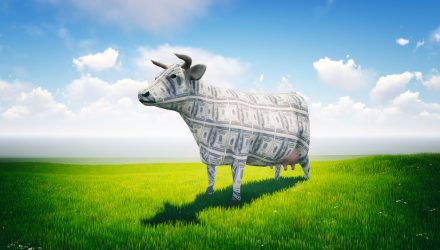Exchange traded fund investors can consider a new way of thinking about Value and look to a handful of products that use this new approach.
In the recent webcast, Don’t Surrender on Value, Sean O’Hara, President, Pacer ETFs Distributors, explained that value investing does not mean an investor has to give up on innovative companies, pointing out that 35% of Russell 1000 technology companies now show a price-to-earnings ratio below market value. He also argued that value investing is also about regular rebalancing to adhere to a rules-based investment methodology and to target the best value in the market place.
For example, the Pacer U.S. Cash Cows 100 Index, which acts as the underlying benchmark for the Pacer U.S. Cash Cows 100 ETF (NYSEArca: COWZ), has benefited from this rules-based approach.
“Since the recovery from March 2009 when the Russell 1000’s P/E was around 11, the price to earnings ratio has expanded 93.50% in the Russell 1000. By rebalancing, the Pacer U.S. Cash Cows 100 Index has maintained P/E’s at lower valuations while offering higher capital appreciation,” O’Hara said.
Currently, this type of value play provides a very cheaply discounted opportunity for long-term investors. Specifically, the Pacer U.S. Cash Cows 100 Index shows a -50.55% discount to the Russell 1000 Index, compared to its historical average of -32.79%. Additionally, the Pacer U.S. Cash Cows 100 Index even trades at a -40.80% discount to the Russell 1000 Value Index, compared to its historical average of -22.25%.
COWZ is an objective rules-based methodology that uses a quality screen to select the top companies in the index universe. The underlying index selects companies from the Russell 1000 Index and screens those based on average projected free cash flows and earnings over each of the next two fiscal years, excluding financial companies other than real estate investment trusts. Component companies are ranked by free cash flow yield for the trailing twelve-month period, and equity securities of 100 companies with the highest free cash flow yield are included in the underlying index. Holdings are also weighed in proportion to their trailing twelve-month free cash flow with a capped 2% of the weight of the index for any individual company.
The result is an indexing methodology that has provided high free cash flow yields, low price-to-earnings ratios, improved upside capture ratios, and lower downside capture ratios, producing an investment strategy with enhanced long-term risk-adjusted returns. Specifically, as of the end of June 2020, the Pacer U.S. Cash Cows 100 Index showed an 8.67 free cash flow yield, 11.57 P/E, 116.38 upside capture ratio to the Russell 1000 Index, and a 95.82 downside capture ratio to the Russell 1000. In comparison, the Russell 1000 had a free cash flow yield of 3.35 and a P/E of 23.04.
O’Hara pointed out that the Pacer U.S. Cash Cows 100 Index’s exposure to strong balance sheets and attractive valuations have started to be rewarded, with continued outperformance against the Russell 1000 Value benchmark and attractive valuations on free cash flow yield and P/E ratio.
Investors can also gain exposure to the same strategy for various other market segments. For example, the Pacer US Small Cap Cash Cows 100 ETF (BATS: CALF) is based on the S&P SmallCap 600 Index and also focuses on those with the highest trailing free cash flow. Similarly, the Pacer US Small Cap Cash Cows Index has produced higher free cash flow yields, lower P/E ratios, improved upside capture ratios, and lower downside capture ratios than the benchmark S&P SmallCap 600 Index. CALF is trading at a relatively cheap value on a historical basis as well.
For international exposure, investors can also take a look at the Pacer Developed Markets International Cash Cows 100 ETF (BATS: ICOW), which is based on the FTSE Developed Ex-U.S. Index and tracks those with the highest trailing 12-month free cash flow.
Financial advisors who are interested in learning about value investing can watch the webcast here on demand.
